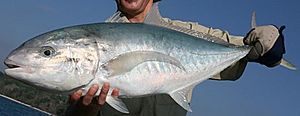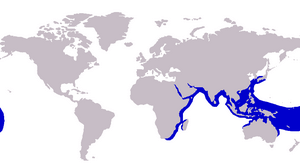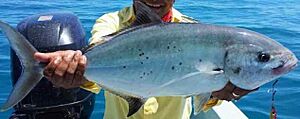Bludger (fish) facts for kids
Quick facts for kids Bludger (fish) |
|
|---|---|
 |
|
| Conservation status | |
| Scientific classification | |
 |
|
| Approximate range of the bludger | |
| Synonyms | |
|
The bludger (Carangoides gymnostethus) is a large fish found in the ocean. It's also called the bludger trevally, nakedbreast trevally, or Bleeker's jackfish. This fish belongs to the jack family, called Carangidae.
Bludgers live in warm, tropical, and subtropical parts of the Indo-west Pacific Ocean. You can find them from South Africa all the way to Japan and New Caledonia. They are big fish, growing up to 90 cm long. They look a lot like the yellowspotted trevally. But you can tell them apart because the bludger has no scales on its chest.
These fish live in moderately deep coral and rocky reefs away from the shore. They eat small crustaceans like shrimp and crabs, as well as other small fish. We don't know much about how they reproduce. However, they seem to move to warmer waters to spawn (lay eggs).
Bludgers are somewhat important for fishing. People catch them with hooks and lines, or with different kinds of nets. They are also popular with anglers (people who fish for sport). But many anglers think they don't taste very good. This is because their flesh is soft and oily. So, they are often used as bait instead of food. The name 'bludger' might come from the fish's blunt head. Or it could be because professional fishermen often discard them.
Contents
About the Bludger Fish
The bludger fish is part of a group called Carangoides. These fish are commonly known as jacks and trevallies. The Carangoides group is in the jack and horse mackerel family, Carangidae. This family is part of the larger order called Carangiformes.
A French naturalist named Georges Cuvier first described this species in 1833. He found a sample in the Seychelles and named it Caranx gymnostethus. The name 'gymnostethus' means 'naked breast'. This refers to its chest, which has no scales. Later, the fish was moved to the Carangoides group.
In 1851, Pieter Bleeker thought he found a new species. He named it Carangoides gymnostethoides. This name means 'like Carangoides gymnostethus' because it looked so similar. But later, scientists realized it was the same fish. So, Carangoides gymnostethoides became a junior synonym. This means it's an older, less used name for the same species.
The unusual common name 'bludger' has two possible origins. One idea is that it refers to the blunt shape of the fish's snout. The other idea is that it describes what happens to the fish when professional fishermen catch it. They might treat it as a discard if they are looking for more valuable fish. In both cases, 'bludger' refers to something used to hit or strike.
What Does a Bludger Look Like?
The bludger is a big fish. It can grow to at least 90 cm long and weigh up to 14.5 kg. Its body shape is similar to the yellowspotted trevally. It's more stretched out and round like a cylinder than most other Carangoides fish. When young, the fish is more oval. As it gets older, it becomes longer. The top of its head and neck also become less steep.
The bludger has two separate dorsal fins (fins on its back). The first dorsal fin has 8 stiff spines. The second one has 1 spine and 28 to 32 soft rays. The front part of this fin is shorter than the fish's head. The anal fin (fin on its belly) has two spines at the front that are not attached. Then it has 1 spine and 24 to 26 soft rays. The pelvic fins (fins on its underside) have 1 spine and 18 to 20 soft rays.
The lateral line (a sensory line along its side) has a gentle curve at the front. This curved part is a bit longer than the straight part. The curved part has 78 to 80 scales. The straight part has 15 to 19 scales and 21 to 27 scutes (hard, bony plates). The fish's chest has no scales. This bare area goes from its pelvic fins up to its pectoral fins (side fins). In adult fish, the mouth is level with the eye. Both jaws have bands of small, brush-like teeth. There are 27 to 31 gill rakers (structures that filter food) and 25 vertebrae (backbones).
Young bludgers are silver-green. Adult bludgers are green-blue to olive green on top and more silvery underneath. At any age, the fish has a few brown or golden spots along its side. These spots are much fewer than on the yellowspotted trevally. The dark spot on its gill cover is often hard to see. The dorsal, anal, and caudal fins (tail fin) are olive green. The soft dorsal and anal fins have white tips. The anal fin also has white edges. The pelvic and pectoral fins are clear to green.
Where Bludgers Live
The bludger lives in the tropical and subtropical parts of the Indian Ocean and western Pacific Ocean. You can find them from South Africa along east Africa and north to the Red Sea. In the Indian Ocean, they spread east to India, South East Asia, Indonesia, and as far south as northern Australia. In the Pacific Ocean, they go north to Japan and out to New Caledonia, Tonga, and the Kapingamarangi Atoll.
Bludgers live in moderately deep offshore waters. They prefer rocky and coral reef areas. They are rarely found close to the shore.
Bludger Behavior and Fishing
Young bludgers swim in small schools. As they get older, they tend to become more solitary. Bludgers have a soft mouth and weak jaws. This limits what they can eat. Studies show they mainly eat prawns, small crabs, mantis shrimps, and small fish. Research in Australia found that bludgers eat mostly crustaceans. Meanwhile, yellowspotted trevallies eat mostly fish and cephalopods (like squid). Bludgers themselves are eaten by sharks, including the blacktip shark (Carcharhinus tilstoni).
Not much is known about how bludgers reproduce or grow. Some observations in South Africa suggest they might move to warmer waters in Mozambique to spawn (lay their eggs).
The bludger is not a major target for fisheries. People catch them with hooks and lines, gill nets, and different kinds of fish traps. Their catch numbers are often not recorded separately. This is because they are grouped with other trevallies.
Bludgers are also interesting to anglers (people who fish for sport). How much interest there is depends on the country. In South Africa, boat anglers and spearfishermen consider them a good catch. They are generally thought to be good to eat there. In Australia, they are still seen as a good gamefish. But they are not as highly valued as other related species, like giant and bluefin trevally. Australians often consider them poor table fare (food). Their soft, oily flesh is often used as bait when fishing on reefs. You can catch them using small baits or lures.
See also
 In Spanish: Carangoides gymnostethus para niños
In Spanish: Carangoides gymnostethus para niños



